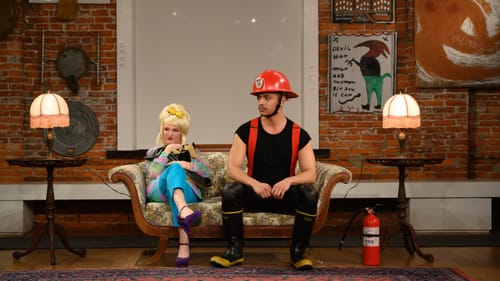Stay in the Loop
BSR publishes on a weekly schedule, with an email newsletter every Wednesday and Thursday morning. There’s no paywall, and subscribing is always free.
Why revisit Ionesco?
Idiopathic Ridiculopathy Consortium presents Eugène Ionesco’s ‘The Bald Soprano’

Idiopathic Ridiculopathy Consortium’s (IRC) latest take on The Bald Soprano begins with “Road to Nowhere” by Talking Heads. Ionesco’s “anti-play” concludes with the same group’s “Once in a Lifetime.” The progression to David Byrne’s signature befuddled refrain in that final song—"How did I get here?”—sums up absurdist theater more succinctly and thoroughly than any dissertation.
The journey, not the destination
With absurdism, the journey matters more than the destination. Amidst the fascinating and incongruous outsider art that dots the walls of Bethany Mission Gallery, which has quickly become this troupe’s preferred venue, director Tina Brock and her committed company lead their audience on a sublime trip through the ridiculous.
To say that Brock makes the material cohere would be inaccurate—Ionesco had no interest in plot or drama as Western theater conceives of it, and his plays are purposefully abstract and, in some moments, indecipherable. The goal of the viewer should be to investigate what they take from the experience, not whether they’ve “understood” something the author set out for them to decode. A good interpretation should leave you asking questions: why do we call some things “ordinary” and some “absurd”? What does “meaning” actually mean?
Words as weapons
The IRC production begins on a melancholy note, lacing the post-dinner prattle spoken by Mr. and Mrs. Smith (played by Bob Schmidt and Brock) with resignation. Perhaps they have realized the ultimate hollowness of their endless exchanges—the futility of their communications to actually convey anything. They can say whatever they like, but they’re always left speaking past each other.
Such an opening salvo might give the impression that Brock seeks to strip the play of its humor. No need to worry. Before long, Ionesco’s non-sequitorial language bombs begin detonating with the right amount of sly spark, particularly when delivered by Tomas Dura as the Smiths’ wry maid, Mary. (The casting of Dura, an older male actor, as a gamine young servant is the production’s own sly joke.) The confounding interaction between Mr. and Mrs. Martin (John Zak and Sonja Robson, both priceless)—a married couple who can’t seem to figure out whether they actually know each other—builds in comic tension before boiling over into disturbing disorientation.
Brock balances the comedy and depravity of Ionesco’s worldview with a steady hand. She also underlines the playwright’s wide-ranging influence in ways I’d never previously considered. The mirroring of the two couples, each fraying at the edges of middle-class respectability in their own unique ways, surely affected Edward Albee, who used similar devices to skewer societal values in Who’s Afraid of Virginia Woolf? and A Delicate Balance. His words-as-weapons approach to playwriting has modern-day disciples like Will Eno and Anne Washburn.

Same play, fresh eyes
This is IRC’s second stab at the play, having previously staged in 2017, in the same gallery space. While the company’s previous assumption hewed closely to Ionesco’s vision of middle-class British conservatism, Brock’s current vision resets the action in a swinging-sixties London milieu. I would have liked more direct engagement with the period and its sense of upheaval, which ideally suits the playwright’s investigation of social systems as rigid but ultimately false constructs. But the new environment offers its own sui generis rewards—like Erica Hoelscher’s psychedelic costumes, which look good enough to eat.
Although this zany, intrepid company made its name on the works of absurdists like Ionesco, it surprised me that they would revisit The Bald Soprano so soon after their last traversal. But at a time when words, and the concept of truth, rapidly lose their meaning, Ionesco still has much to teach us. Artists and audiences must continually meet a play like The Bald Soprano with fresh eyes.
And about that title? After barging in on the bizarre ménage à quatre, a Fire Chief (Carlos Forbes, delectable) poses a curious question: “Speaking of that—the bald soprano?”
“She always wears her hair in the same style,” Mrs. Smith replies. That may be true for her, but the IRC is more than willing to change with the times.
Full disclosure: I consulted on and wrote program notes for IRC’s production of William Inge’s Come Back, Little Sheba.
What, When, Where
The Bald Soprano. By Eugène Ionesco. Directed by Tina Brock. Idiopathic Ridiculopathy Consortium. Through February 16, 2020, at the Bethany Mission Gallery, 1527 Brandywine St., Philadelphia. (215) 285-0472 or idiopathicridiculopathyconsortium.org.
A chair lift is available to the second floor of the Bethany Mission Gallery, where the performance takes place. Patrons with specific questions about accessibility may contact [email protected].
Sign up for our newsletter
All of the week's new articles, all in one place. Sign up for the free weekly BSR newsletters, and don't miss a conversation.

 Cameron Kelsall
Cameron Kelsall